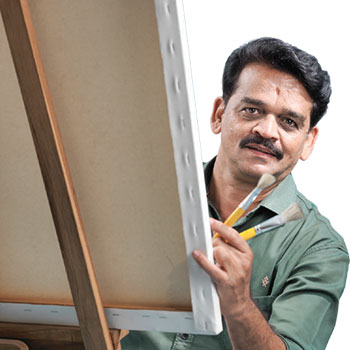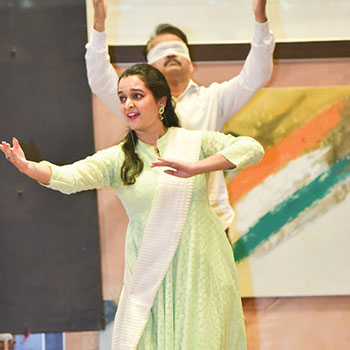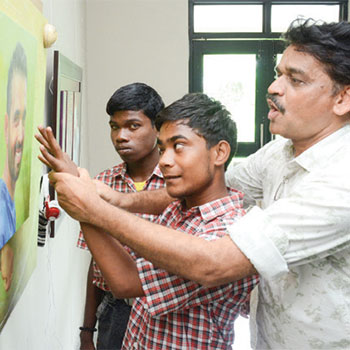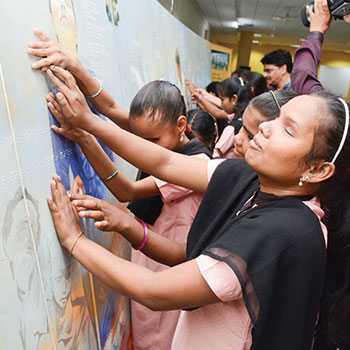Art of the heart

What if art could be felt, not just seen? Well, Chintamani Hasabnis, a Braille artist, through his visual artwork, has made it possible. He is dedicatedly working to make his paintings visible to the visually impaired people by combining his artistic storytelling and Braille on the canvas. Through his exceptional Braille artwork, he has proved that beauty not only lies in the eye but in the hearts and hands of the beholder

Like many other young graduates, Chintamani completed his education in fine arts and began his career as a full-time artist in 1988. However, there was a twist in his story, he was strongly inclined towards the upliftment of the society, and he found that medium through his artwork. He says, “When I graduated, I was very clear that my art should be used for the welfare of society. So, I decided that till the time my artwork is not being utilised for social welfare, I will work as a regular artist.”
Artist Chintamani has worked for eminent personalities of the country, including former President APJ Abdul Kalam, tabla maestro Zakir Hussain, former Indian cricket team captain Sachin Tendulkar, and playback singers Lata Mangeshkar and Sonu Nigam. For 25 years, he worked as a regular painter—which earned him a lot of respect and provided him with financial stability. Even after achieving all this, thoughts on contributing to society kept reverberating in his mind. “I was happy with my work, but somewhere I was not fulfilled with what I was doing. Fortunately, after working for over two decades, I was able to identify my true calling,” says Chintamani.
Art beyond visuals
Back in 2013, Chintamani, while passing through a traffic signal, saw a little girl confidently crossing the road at a zebra crossing. He noticed a white stick in her hand and realised that she was visually challenged. He recalls, “She walked so positively that it was difficult for anyone to tell at first sight that she was not an ordinary girl. I was left struck at that moment. I kept on thinking that thousands of people praise me for my art, but what about these visually impaired? Will I be able to make my painting see to the visually challenged?”
Days passed by, but the questions raised at that traffic signal consumed Chintamani completely, so much so that one fine day he decided to work on Braille artwork for visually impaired. He began researching whether such work had been done before or not. He says, “One fine morning I decided to work on this idea of creating an artwork that visually challenged people can ‘see’ and feel.”
It took Chintamani, about two and a half years to master the skill of Braille painting. Bringing the painting with Braille texture on the canvas was full of challenges. He used to visit schools and hostels for visually impaired children and observe their activities carefully. “I just wanted to understand how visually challenged people perceive the world,” he says.
Painting a new canvas

Taking inspiration from the school for the visually challenged, Chintamani started learning Braille tactical codes from scratch. Right from learning the Braille alphabet to constructing thoughtful sentences, this practice took him eight months to understand completely. Initially, he practiced on A4-size paper, but taking this art to the big canvas was quite a daunting task for him. “Gradually, with perseverance and precision, I learned to create Braille texture on the canvas,” he expresses.
In 2022, Chintamani completed his first Braille painting of classical musician and Santoor player, Pandit Shivkumar Sharma. He created this painting in four pieces to give a seamless understanding of the picture. He also used 85 real Santoor strings in the artwork to give the perceivers an authentic experience. He says, “After completing my first artwork, I called two of my visually impaired friends to experience this without telling anything about the use of Braille.”
When his friends began to touch the painting, they were making several assumptions, creating a picture in their mind. As they touched the Braille textures, they started to ‘see’ the painting through their sense of touch. “Hey look, I can see something here,” said one of his friends while experiencing Chintamani’s first Braille painting. They even played the strings incorporated in the painting. “I cannot describe the joy and happiness I saw on their faces. This was the moment when I realised that a revolution has taken place,” grins Chintamani. “Initially, it used to take around a month to complete such artworks, however with practise, I create a Braille painting in 10 days now,” he added.
"Across these years, I have witnessed that the way visually challenged people feel and understand the soul of the painting, there are very few sighted people who can recognise the soul and message in the painting"
-Chintamani Hasabnis
Exhibition experiences

So far, in two and a half years, Chintamani has created 30 such paintings that were exhibited across the country. His first exhibition of Braille painting at The Nehru Centre, Mumbai, witnessed hundreds of people, including the 600 visually impaired. “I cannot express how overwhelmed and humbled I was by the responses,” he expresses. Sharing some of his experiences, he mentions that one day a lady contacted him through Facebook with a request to make a painting of her four-year-old son, so that her visually impaired husband can ‘see’ their child.
Another experience was from Prerna Association for the Blind (PAFB) founder, Satish Navale. He approached Chintamani to paint a picture that captures the life of a soldier, which they could present to the army personnel deployed at the Indo Pak border near Punjab. While showing this artwork to the army personnel, the visually impaired of PAFB also explained the elements present in the painting. Chintamani says, “I named this painting ‘the border' and I keep it with me in every exhibition.” He also informed that some of these Braille paintings are displayed in the President of India’s house, which he considers one of his significant achievements.
Art for all
The objective to create Braille paintings, as Chintamani says, was to bring the sighted and visually-impaired people together. “Across these years, I have witnessed that the way visually challenged people feel and understand the soul of the painting, there are very few sighted people who can recognise the soul and message in the painting,” he articulates.
Most of the exhibitions of Chintamani are focused on social awareness. Sharing the experiences from one of his unique exhibitions, he informed that he was working on a campaign to spread awareness of gynaecological problems in women. For that, he created a Braille painting on the bonnet of a Mercedes car and drove from Pune to Goa. “Wherever the car stopped during the rally, a throng of people came to know more about the campaign. Even the girls who were visually challenged learned about women’s health through this artwork.”
Going global

Currently, Chintamani is preparing to take his artworks to a global audience. He recently attended an international conference conducted by the International Council for Education and Rehabilitation of People with Visual Impairment, Europe region (ICEVI-Europe), where, as a speaker, he talked about educating visually challenged people through paintings.
Some of his artworks have also been selected for exhibitions in Germany and Italy. In these exhibitions, he will showcase his Braille paintings based on Indian culture, the essence of being a human, globalisation, and education. He says, “I would like to request corporate people and educational institutes to host such painting exhibitions, so we can educate more and more visually impaired people.”
Family and passion
For every initiative and success, Chintamani always thanked his family, who held his back during his struggle days. He says, “Although, helping society has always been my dream, however, without the support of my family, I could not have achieved it. They stood by me through thick and thin. Even today, we sit together and discuss the ideas for the betterment of society, especially for visually impaired.”
The Braille paintings, as Chintamani says, gave him mental peace and inner happiness. The audio, comments, remarks, and videos of appreciation from the people encourage him to work even harder. “For me, art is what we feel and understand. Through my Braille artwork, I wish that I will be able to inspire everyone and make them experience the beauty and depth of art,” he signs off.